With finals footy starting to heat up we are now left with only four remaining teams, the Melbourne Demons, the Port Adelaide Power, the Geelong Cat, and the Western Bulldogs.
After the Bulldogs and Lions provided us with one of the games of the season, excitement is starting to increase over who will win the premiership in 2021.
While Melbourne and Port Adelaide are looking like the teams to beat, all four sides have played at the level of winning any of the remaining matchups. Injuries, experience, history, and form all play an important role in who will be the eventual winner.
Will the Demons break the longest grand finals drought in football? Will Geelong break their finals hoodoo since Hawthorn broke the Kennett Curse? Will the Bulldogs win another premiership from outside the top four? or Will Port Adelaide finally deliver on all the promise they have been showing over the past few seasons?
We look at two reasons why each of the remaining teams can and can't win the 2021 AFL premiership trophy.

Geelong
Why they can
Big forwards
Geelong is a team that has talent all over the ground. They possess some elite defenders and midfielders, but this isn't uncommon amongst the remaining sides. What distinguishes Geelong is their two-headed forward combination.
Of the remaining sides, only one team has any player on the list to win the Coleman Medal. Geelong not only has one of those players, but they also have two. Those two medals have also been in the past three seasons.
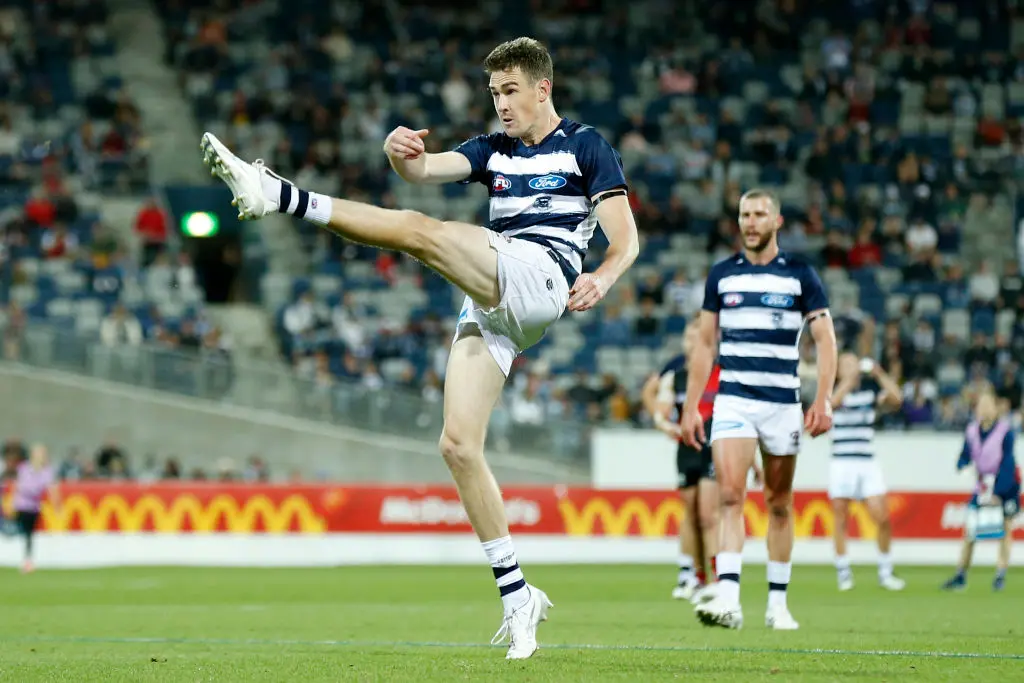
kicks for goal during the AFL Community Series match between the Geelong Cats and the Essendon Bombers at GMHBA Stadium on March 06, 2021, in Geelong, Australia. (Photo by Darrian Traynor/Getty Images)
While Tom Hawkins and Jeremy Cameron haven't played a full season together, they have shown flashes throughout the year which has been scintillating to watch. Both forwards have averaged over 2.5 goals per game for the season. Injuries and absences have been the only thing stopping these two from running havoc throughout the league.
Both forwards provide a strong lead-up target going into 50, while also capable of taking a contested mark. Geelong had the 2nd most marks inside 50 (12.9) per game, with Cameron and Hawkins making up 5.5 of those grabs.
They also manage to share the ball around with other forwards and generates plenty of opportunity for teammates. Both Cameron and Hawkins average over seven score involvements per game.
Having the two best forwards left is a significant advantage for the Cats, and will also cause headaches for opposition defenders.
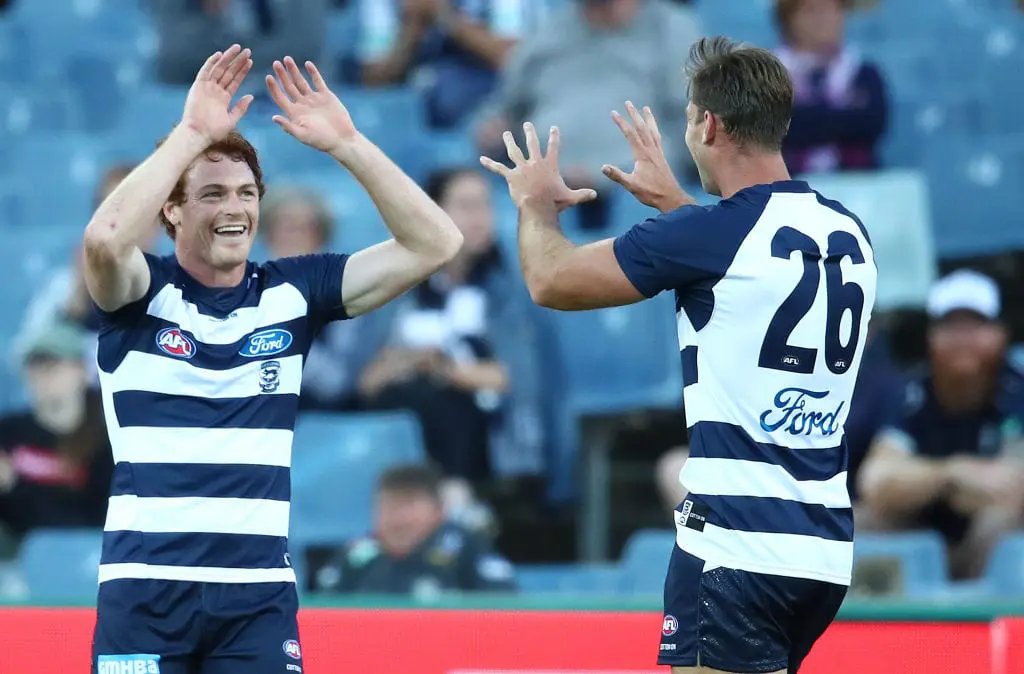
For example, Hawkins was on fire last week against GWS kicking five in the elimination final. He also recently kicked four against the Demons in their round 23 loss. Jeremy Cameron kicked two goals in both of those matches but took the lead in other matches throughout the year. Against Port Adelaide in round 13, he booted five of his own goals and had 6 against the reigning premiers earlier in the season.
In any given game either of these two forwards could kick a bag of goals. Their opposition will have to be flexible and versatile enough to focus on whoever is being most damaging during that match. It is a scary prospect that one of those two players won't be facing the opposition's best defenders in the match.
Even the stacked Melbourne backline can struggle against Cameron and Hawkins. May will obviously take one of the pair, but Lever is best utilised as a player who can take intercepts and play off his man. Against either of these two forwards that could be a recipe for disaster and lead to a big haul of goals for one of the Geelong forwards.
Finals experience
With Richmond's domination over the past four years, it has been difficult to make it through to the Grand Final. Of the remaining four sides, only Geelong has had any recent grand finals experience.

While not winning a grand final since 2011, the Cats have been in with a chance throughout the past decade. Due to this, their players have been given plenty of finals experience throughout that time.
Of current active players, Geelong has six of the most experienced 11 players when it comes to finals. Joel Selwood, Tom Hawkins, Isaac Smith, Gary Rohan, Mitch Duncan, and Patrick Dangerfield have all appeared in 22 or more finals matches.
Mark Blicavs, Cameron Guthrie, Lachie Henderson, Sam Menegola, Jake Kolodjashnij, and Zach Tuohy are also in the top 30 of finals played amongst active players.
No other club left in the finals even has one player within the top 30.
This does give Geelong a distinct advantage over its competitors. Finals are different from the home-and-away season, with the pressure and expectations increasing the further you progress. As the finals go on, the Cat's advantage increases with their experience of playing in those big moments.

The Bulldogs are the only other club to have achieved grand finals success over the past decade, but their list is significantly different from the underdog story of 2016. They have also had fleeting success since, having not returned to the grand final.
Along with total finals experience, they are also the only club remaining to taste defeat in a grand final. Last year's result has given them further motivation and hunger in order to go one better than 2020. Other clubs haven't felt the pain of losing in the grand final and having to watch your opponents be awarded their premiership medals.
While some of the other clubs might have some bigger stars, none of them have endured the battles that Geelong has gone through. This finals experience will serve them greatly as other clubs face the expectations of millions of viewers watching and cheering around the globe.
Why they can't
Defence
While the defense has been one of the cornerstones of Geelong's success since 2007, cracks are starting to show in back six. From the outside, things appear solid for the cats. They kept their opposition to the 2nd lowest score (63.3) per game. When you start to look further, however, the defense does have some glaring flaws.

Geelong's game style has hidden a lot of those issues throughout the season. They control the pace of the game and are high possession team. They lead the league in kicks, disposals, and marks while being in the top two of kicks and disposals against. By controlling the tempo, they have been able to keep opposition scores down.
Since the injury to their best defender Tom Stewart, some of those issues have been exposed. Despite having Stewart being in the top ten of intercepts for the league, the Cats are still last in the competition in that category with 63.8 per game. Without him, they fall even further behind.

The low number of intercepts has hurt their ability to rebound the ball from 50 quickly and efficiently. They are also 3rd last in rebound 50s, which ranks them below all other finalists. This not only adds pressure onto their defenders but slows down the play. Doing this allows their opponents to set up their defensive structures behind the play.
Geelong's next best defender is Mark Blicavs, who has bounced between the backline and ruck over the past few years. With Rhys Stanley having inconsistent form throughout his career, there is no guarantee he will continue his recent success over the next two weeks. If he starts to have no impact on the game or needs to be rested then Chris Scott often has to put Blicavs back in the ruck.
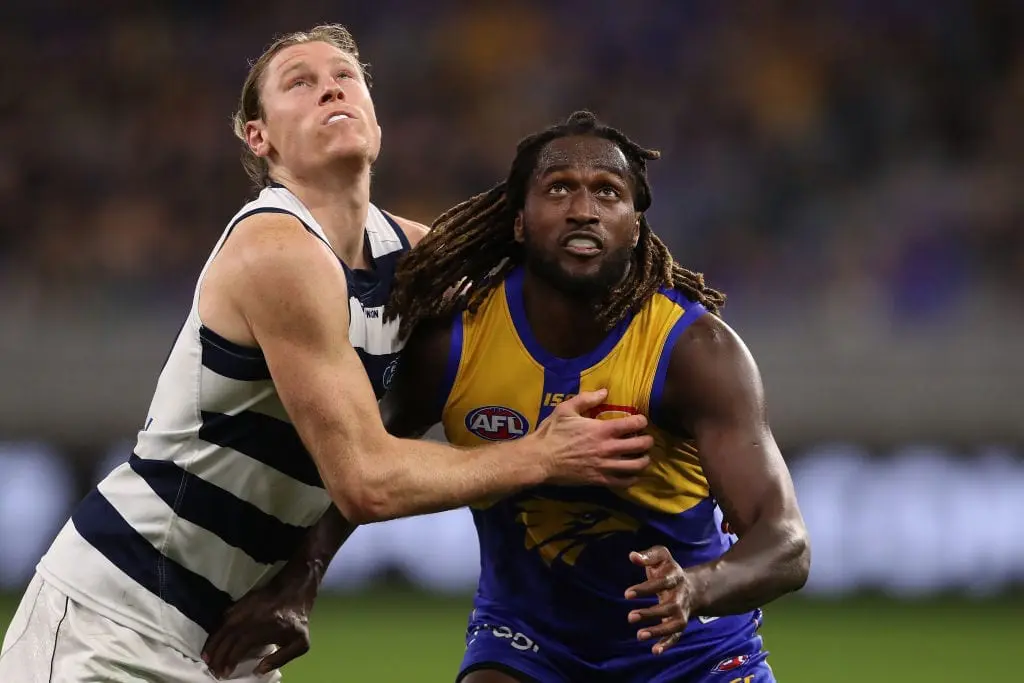
While Scott might not consider making the switch full-time, the absence of Stewart makes it a difficult decision. The situation often comes up where he has to make a sacrifice in either the ruck or defense.
Lachie Henderson is the Cats' fullback and has taken the number one forward in recent weeks. Two weeks ago when the Cats played the Power, he was manned up on Charlie Dixon. Dixon and the rest of the Power forwards took control of the game and created many unsettling moments for the Cats defence. Henderson and his other defenders turned the ball over or made multiple mistakes that lead directly to Power goals.
The defensive issues can be felt all around the ground, however, with tackling pressure being an issue for the club. The Cats also average the lowest number of tackles per game out of the finalists, completing 56.4 per game. This also includes the tackles inside forward 50 having 9.6 per game, meaning they are the only club to have less than 10 per game left in the finals.
Against the premier midfielders that Port Adelaide, Western Bulldogs, and Melbourne all possess, the Geelong defence won't have the same reprieve that they are used to. Against Port Adelaide in the first week of the finals, the Cats lost the midfield battle which resulted in the Power hitting the scoreboard and producing a large lead.
Finals Record
While routinely playing in finals, the Cat's success from 2007-2011 hasn't carried over to the remainder of the decade. After winning in 2011, the Cats have struggled to find continuous success, with 2020 being the only season to make the Grand Final.

Over that span, Geelong has played in 21 games. Their record is 7-14 for those matches.
In the finals, the games get tougher and the opposition has had more time and focus on planning around stopping your game. While Geelong isn't always the highest-scoring team in the competition, in finals their slow and methodical ball movements impede their ability to generate scoreboard pressure.
What this has resulted in is Geelong struggling to kick a winning score. Over this same span of games, Geelong has only kicked more than 80 points in just nine of their 21 matches. They have also only managed to score above 100 on two occasions.
While the Cats have been able to win a few of these matches, it does demonstrate the negative side of their high possession game style. When games are close and low scoring, it gives their opponents hope and also the ability to catch back up quickly.
One of the best examples of this was last year's grand final. Geelong had all the momentum and had the game in their hands throughout the first half. The Cats were unable to convert that to a large margin only leading by 15 at halftime. All it took was some Richmond (and Dustin Martin) magic to blow the game open and then the game was lost.
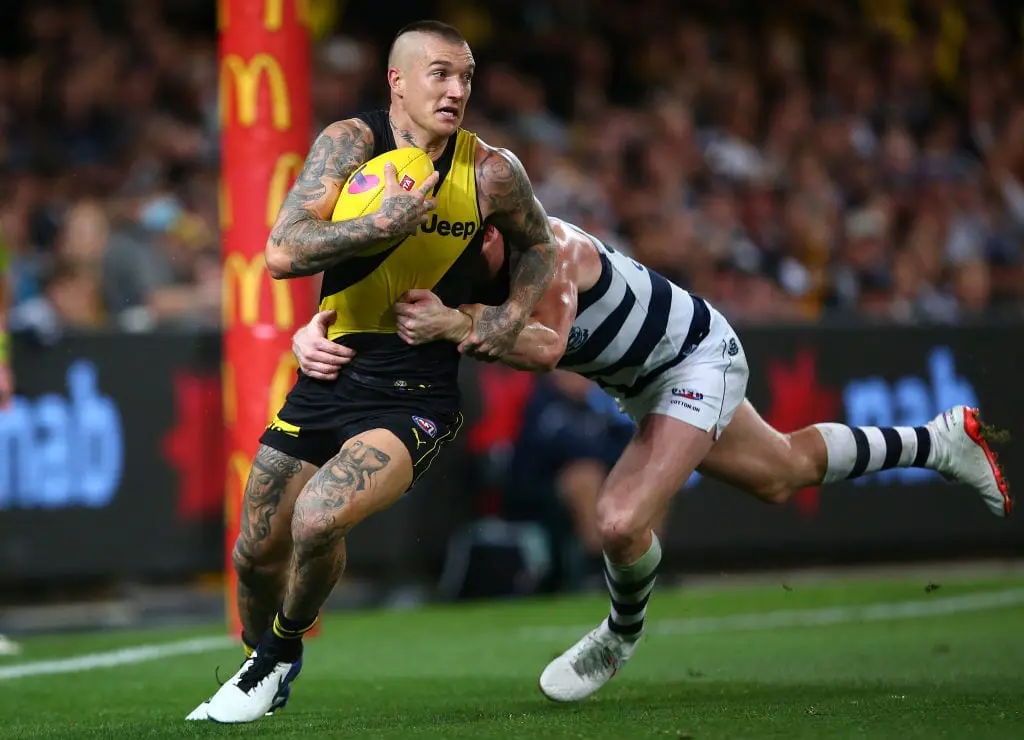
The Cats are the only remaining team with such a large finals record because of their consistency throughout the 2010s and the age of their list. Geelong has the oldest list in the league with an average age of 25.4 years. Melbourne's average age is 24.6, Port Adelaides is 24.4 and the Bulldogs is 24.7.
The age difference is even larger when you look at the Cat's reliance on older players. Shaun Higgins, Joel Selwood, Tom Hawkins, Isaac Smith, Zach Tuohy, Lachie Henderson, Patrick Dangerfield, Rhys Stanley, Mark Blicavs, Gary Rohan, and Mitchell Duncan are all over 30 and likely playing on the weekend.
Most of these players have been a part of the club throughout a large portion of these disappointing seasons.
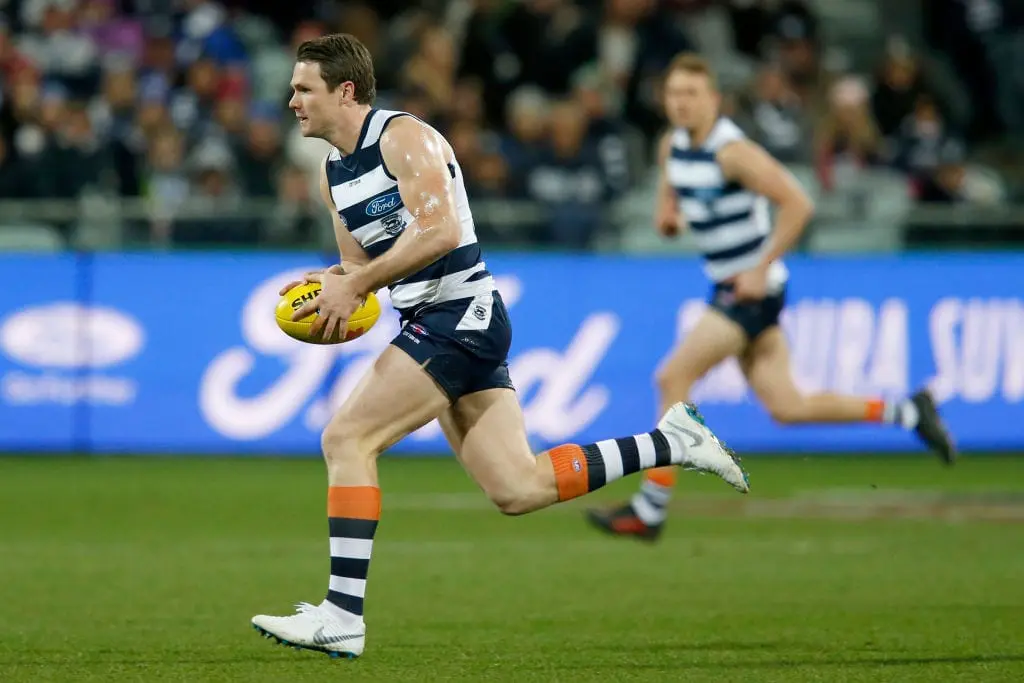
With the age profile of the club and the recent record, it will be a challenge for Geelong to be the premiers. They are also playing with borrowed time as each year their core players get one year older and closer to retirement.
To come away with the premiership they will likely have to beat two teams that were higher on the ladder. To do this they will have to have more success than the current 33% strike rate in finals since their last premiership. Otherwise, Geelong will end their year with a 15th loss in finals since 2011.






